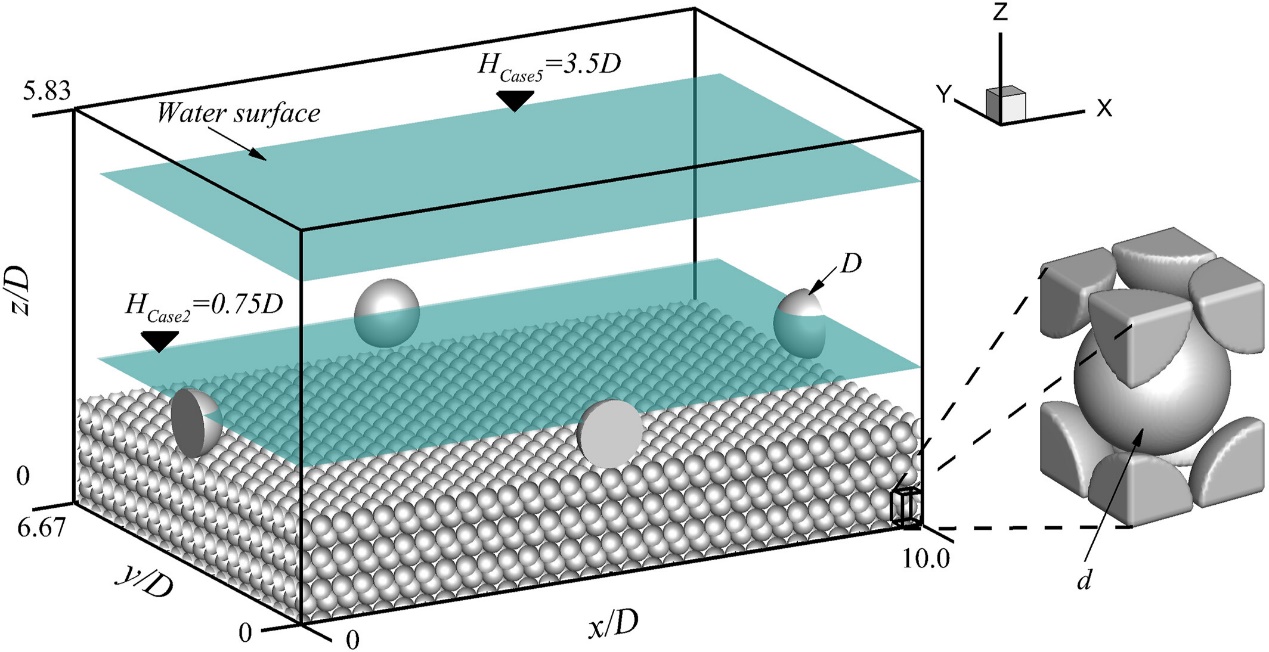
题目 Title
Impact of the Relative Submergence on Turbulence Structures in Open-Channel Flow Through Arrays of Large Spherical Roughness Elements
期刊 Journal
Water Resource Research (IF=5.0)
作者 Author
Tang, Z. D.; Stoesser, T.; Huang, L.; Liu, Y.; Fang, H. W.
摘要 Abstract
This study investigates the impact of relative submergence, defined as the ratio of water depth to the diameter of boulders (k = H/D), on turbulence structures in flow through boulder arrays. The large-eddy simulation method is employed to simulate flow through boulder arrays across a range of k values from 0.25 to 3.50. Within this range, three distinct flow regimes are identified: low (k = 0.25), intermediate (k = 0.75 and 1.25), and high (k = 2.0 and 3.5) relative submergence regimes. Across these three regimes, distributions of time-averaged velocities, secondary flow, turbulent kinetic energy, and dominant turbulence structures in the wakes of boulders exhibit significant variations. The wake of boulders, characterized by recirculation flow, only manifests at k ≥ 0.75 and is more pronounced at higher k values. Particularly at k = 3.5, funnel vortices in the wake and secondary flow at the sides of boulders develop, enhancing vertical momentum exchange. Three types of coherent structures are identified within the wake: (a) the near-bed hairpin vortex with a wavelength (λ) of 0.8D at the lowest k, (b) the lateral flapping of boulder wakes with λ=2.1D intermediate k, and (c) the meandering of high-speed streaks at the side of boulders with λ=10D at high k. These structures alter the distribution of the near-bed Reynolds shear stresses (RSS) and contribute up to 20% of the near-bed RSS. At k ≤ 1.25, a region of low near-bed shear stress appears upstream of boulders, while it shifts to the wake of boulders at k = 3.5, contributing the observed variations in deposition patterns at different k values as reported by Papanicolaou et al. (2018, https://doi.org/10.1029/2018jf004753). In addition, the two bedload periodicities reported in the experiment of Papanicolaou et al. (2018, https://doi.org/10.1029/2018jf004753) are justified by the ratio of the wavelength of lateral flapping of boulder wakes to that of meandering of low- and high-speed streaks.
简介 Brief introduction
本研究探讨了相对淹没度(定义为水深与巨石直径之比,k = H/D)对巨石阵列水流湍流结构的影响机制。采用大涡模拟方法,系统模拟了k值在0.25至3.50范围内的巨石阵列水流,据此划分出三个典型流态:低淹没度(k=0.25)、中淹没度(k=0.75和1.25)及高淹没度(k=2.0和3.5)。研究发现,不同流态下巨石尾流区的时均流速分布、二次流结构、湍动能分布及主导湍流结构均呈现显著差异。其中,以回流为特征的巨石尾流仅在k≥0.75时出现,且随k值增大而增强。特别地,当k=3.5时,尾流区形成漏斗状涡旋结构,巨石侧缘产生强烈的二次流,显著增强了垂向动量交换。通过湍流相干结构识别,揭示了三种典型涡旋构型:(a) 低k值(k=0.25)下近床面发卡涡(波长λ=0.8D);(b) 中等k值下巨石尾流的横向摆动(λ=2.1D);(c) 高k值下巨石侧缘高速条纹的蜿蜒运动(λ=10D)。这些结构显著改变了近床面雷诺切应力(RSS)的分布格局,对近床RSS的贡献最高可达20%。当k≤1.25时,低剪切应力区出现在巨石上游;而当k=3.5时,该区域转移至尾流区,这一现象与Papanicolaou等(2018)报道的不同k值下沉积模式的变异特征相符。此外,研究通过分析尾流横向摆动波长与高低速条纹蜿蜒波长的比值关系,合理解释了Papanicolaou等(2018)实验中观测到的推移质输移双周期现象。
扫码关注立方体公众号,实时追踪课题组最新科研进展



